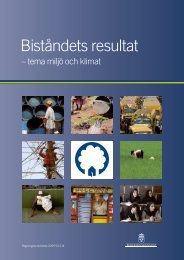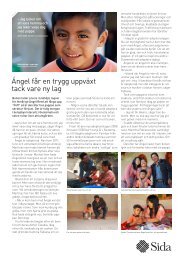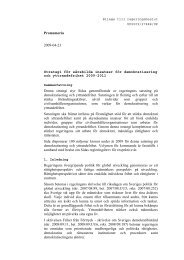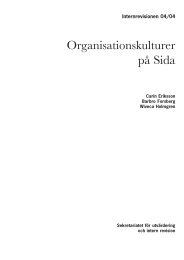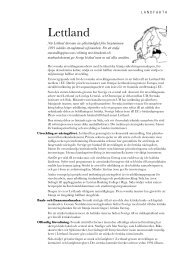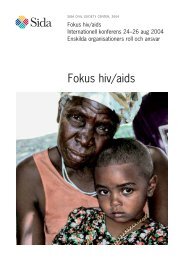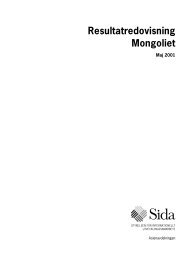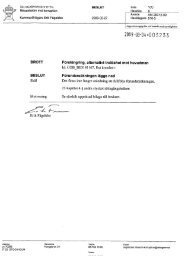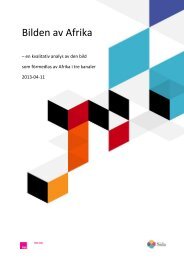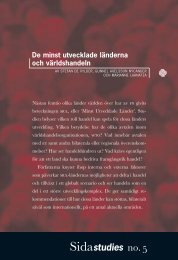Mobilisation of the Poor – a means to Poverty Reduction? - Sida
Mobilisation of the Poor – a means to Poverty Reduction? - Sida
Mobilisation of the Poor – a means to Poverty Reduction? - Sida
Create successful ePaper yourself
Turn your PDF publications into a flip-book with our unique Google optimized e-Paper software.
stimulated <strong>to</strong> reflect on it in a systematic way through an external catalyst with <strong>the</strong> necessary skills,<br />
attitudes and wisdom.<br />
Second, this leads <strong>to</strong> a process <strong>of</strong> probing on <strong>the</strong> part <strong>of</strong> local poor people and groups in<br />
collaboration with <strong>the</strong> external catalyst. This probing is similar <strong>to</strong> <strong>the</strong> now-familiar process <strong>of</strong><br />
Participa<strong>to</strong>ry Rural Appraisal (PRA) but lacks its technological sophistication. One key difference in<br />
CAP probing is that it is undertaken explicitly from <strong>the</strong> point <strong>of</strong> view <strong>of</strong> <strong>the</strong> rural poor <strong>to</strong> help <strong>the</strong>m<br />
overcome <strong>the</strong>ir problems.<br />
Third, CAP sought <strong>to</strong> organise <strong>the</strong> poor, initially in small groups, as a distinctive layer in rural<br />
society. In this respect CAP differed from all <strong>the</strong> o<strong>the</strong>r existing rural mobilization programmes,<br />
such as <strong>the</strong> Department <strong>of</strong> Rural Development’s Rural Development Societies and <strong>the</strong> Sarvodaya<br />
movement’s Sarvodaya Shramadana Samithi, as <strong>the</strong> latter organisations sought <strong>to</strong> unite <strong>the</strong> entire<br />
village community for <strong>the</strong> purposes <strong>of</strong> rural development.<br />
Fourth, this process <strong>–</strong> once introduced by an external agent <strong>–</strong> was expected <strong>to</strong> be internalised and<br />
progress <strong>to</strong>wards a chain <strong>of</strong> collective action. This might take <strong>the</strong> form <strong>of</strong> ei<strong>the</strong>r mutual help (e.g.<br />
building <strong>of</strong> group funds, labour sharing) or campaigns <strong>to</strong> renegotiate relationships with <strong>the</strong> powerful<br />
layers <strong>of</strong> society. Some advocates <strong>of</strong> CAP tended <strong>to</strong> see <strong>the</strong> latter type <strong>of</strong> collective action as more<br />
progressive and more beneficial <strong>to</strong> <strong>the</strong> poor.<br />
Finally, this conscientisation/social mobilisation process did not involve any direct handouts, but<br />
was conceived ra<strong>the</strong>r as a <strong>means</strong> <strong>to</strong> promote self-reliance.<br />
This seemingly radical approach <strong>to</strong> empowerment gave way during <strong>the</strong> 1990s <strong>to</strong> a more sedate<br />
group-building process where savings and lending from savings were <strong>of</strong>ten <strong>the</strong> core activity. This in<br />
turn undermined some aspects <strong>of</strong> <strong>the</strong> empowerment process initially introduced by CAP, but<br />
mobilising <strong>the</strong> poor so <strong>to</strong> act <strong>to</strong>ge<strong>the</strong>r <strong>to</strong> promote <strong>the</strong>ir common interests remained one <strong>of</strong> <strong>the</strong> main<br />
aspects <strong>of</strong> <strong>the</strong> programme. In light <strong>of</strong> liberalisation policies and <strong>the</strong> current emphasis on market-led<br />
growth, CAP-type interventions are increasingly seen as a <strong>means</strong> <strong>to</strong> mainstream <strong>the</strong> poor and<br />
enhance <strong>the</strong>ir integration and comparative advantages within global, national and regional<br />
markets, ra<strong>the</strong>r than as a <strong>means</strong> <strong>to</strong> organise <strong>the</strong>m <strong>to</strong> confront <strong>the</strong> dominant classes <strong>of</strong> society.<br />
In terms <strong>of</strong> empowerment, <strong>the</strong> impact <strong>of</strong> CAP needs <strong>to</strong> be considered from several angles:<br />
1. The conscientisation <strong>of</strong> <strong>the</strong> poor;<br />
2. Improving <strong>the</strong> bargaining power <strong>of</strong> small producers vis-à-vis middlemen;<br />
3. Empowerment <strong>of</strong> women;<br />
4. Empowerment <strong>of</strong> marginalised social groups in general.<br />
Impact <strong>of</strong> CAP on conscientisation and related perceptions <strong>of</strong> <strong>the</strong> poor<br />
As a conscientisation process, one <strong>of</strong> <strong>the</strong> primary objectives <strong>of</strong> CAP was <strong>to</strong> make people aware <strong>of</strong><br />
<strong>the</strong>ir condition and <strong>to</strong> facilitate collective action <strong>to</strong>wards overcoming <strong>the</strong>ir common problems. In<br />
<strong>the</strong> field visits it was evident that CAP participants had no difficulties in declaring <strong>the</strong>mselves as<br />
poor and discussing <strong>the</strong> reasons for <strong>the</strong>ir poverty. The more articulate CAP members (leaders <strong>of</strong><br />
small groups in particular) tended <strong>to</strong> explain <strong>the</strong>ir condition in socio-economic terms. In <strong>the</strong><br />
Household Survey 80.4 per cent <strong>of</strong> current CAP members identified <strong>the</strong>mselves as poor. 1 Asked<br />
1 We are unable <strong>to</strong> compare <strong>the</strong> responses <strong>of</strong> non-CAP members due <strong>to</strong> certain inconsistencies in <strong>the</strong> questions asked <strong>of</strong><br />
CAP members and o<strong>the</strong>rs. These questions were part <strong>of</strong> a wider interest in understanding <strong>the</strong> perception <strong>of</strong> poverty<br />
among <strong>the</strong> programme participants. This is based on <strong>the</strong> assumption that being aware <strong>of</strong> a condition is a pre-requisite for<br />
taking action against it.<br />
30<br />
MOBILISATION OF THE POOR <strong>–</strong> A MEANS TO POVERTY REDUCTION <strong>–</strong> <strong>Sida</strong> EVALUATION 02/08




